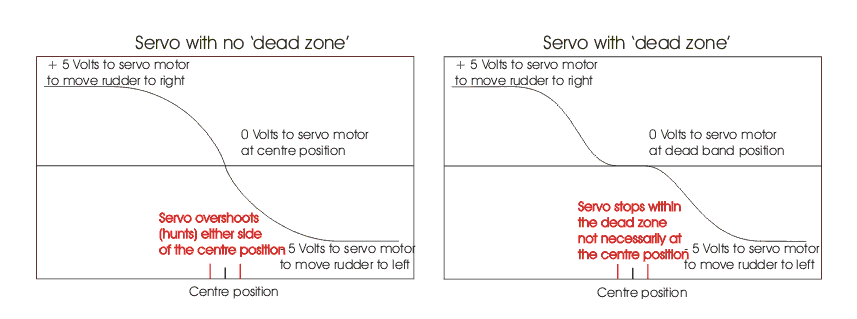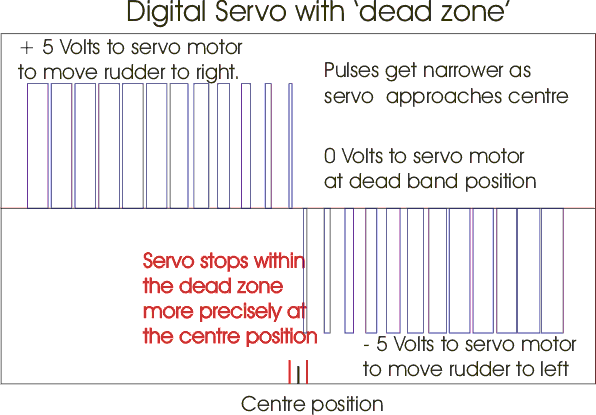Servo Selection - by Ben Morris
Return to Sailing Hints
page to examine other Hints
Lets look at the rudder servo first. Is there any
alternative to the standard common garden type servo which has been around
for 20 years or so. If so are there advantages/disadvantages in
considering the modern 'digital' servos. What exactly does that mean
'digital'? So far as we are concerned, the important difference
between the standard 'analogue' servo and the digital servo is the way in
which the power is supplied to the servo motor as it approaches the position
dictated by the transmitter stick.
An analogue servo receives a supply of electricity whose
voltage decreases to zero as it reaches the required position. Should
it go too far it will receive a reverse voltage which sends it back towards
the centre position. If the supply of electricity is supplied too
quickly either side of the centre position the servo is likely to
'overshoot' the centre position because of the inertia of the motor, It will
then head back towards the centre position and if too much push given it
will overshoot on the other side. The result is the servo sits
there going backwards and forwards overshooting the centre position - it is
said to hunt about that centre position. While this gives a good
average position in the centre, the servo is constantly drawing current.
arcing at the motor commutators and getting warm even hot. All
manufacturers include a 'dead band' where no voltage is supplied to the
servo motor for a small displacement either side of the centre point.
This allows the servo to stop before it reaches the point where it starts
going backwards. This means the servo may stop anywhere in the dead
band which translates to the rudder pointing anywhere within an equivalent
dead band. A rudder may end up anywhere within a 2 - 3 degrees
of dead band. So you set up your rudder to centre and then move the
rudder to the left then release to centre or move it right and release to
centre only to find the rudder is no longer in the same centre! It may
be anywhere within the dead band. A similar situation applies when a
small movement of the rudder is required using the trim lever to correct a
small tendency to drift to the left or right. If the trim action
occurs within the dead band region no actual movement occurs until the
required position occurs outside the dead band.

Manufacturers try to reduce the size of the dead band by
reducing the inertia of the motor and using a form of electronic feedback (feedforward?)
which reduces the voltage as it approaches the centre position dependent on
the speed it approaches. Often they are made with no or little
rotating iron or as little as possible to reduce its inertia. Coreless
motors are one way to do this where the rotating part only consists of the
windings or wires - no iron!. These can be expensive though and
because they have.
Digital servos are constructed identically to normal servos
except they use a microprocessor to control the electricity flowing to the
motor. Instead of gradually reducing the voltage supplied to the motor
as it approaches the centre point, a digital servo supplies a series of
pulses of the full 5V to the motor but varies the width of the pulse i.e.
making them narrower as the centre position is approached. This
means the motor will always be able to supply its maximum torque right up to
the centre point because each pulse is the full 5V. The microprocessor
allows the servo to gauge more accurately how it approaches the centre point
and reduces the width of the pulses accordingly. This means that the
dead band - still needed for the same reasons can be significantly smaller.
The result is a servo which is far more precise in its positioning with a
smaller dead band. The rudder then will more precisely point in the
direction indicated by the transmitter stick. In addition because its
motion is controlled by a microprocessor, the digital servo can be
'programmed'. The amount of dead band, total travel angle, centre
position are some of the factors which can be varied. The main
disadvantage to such a servo is its higher cost (though this is coming down
fast) and an increase in electrical consumption. Just be aware that
the maximum current able to be supplied by the 'smart winch' of Rob Guyatt'
is ~1 amp so any servo which draws more than this when stalled will cause
issues to the receiver connected to the winch as the voltage will drop maybe
below the minimum for the receiver to operate.

So are the advantages worthwhile? I believe they are
and I use digital servos in both Marblehead and IOM yachts. To be able
to give one or two clicks to the rudder trim on the transmitter and see a
corresponding response to the motion of the boat tells me the small dead
band with a digital servo is a worthwhile investment. Check what one
click on your system does.
What about sail servos (winches) because after all they are
just glorified servos with similar technologies but with a multiple turn
output instead of 110°. Sure the bearings and the cogs are beefed up
but their electronics operating principle is the same as a servo. In
Australia and I suspect the world, the Rob Guyatt designed 'Smart Winch' is
just about in a league of its own. Not only is the winch 'digital' in
operation but the later versions use mosfets (output transistors) with
greater power handling and lower voltage drop then standard bipolar
transistors giving more torque to the winch for the same voltage. As
well, many functions of the winch are programmable allowing great
flexibility.